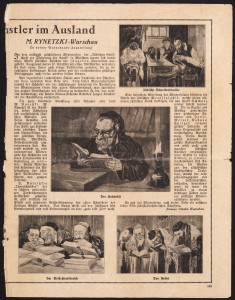Those of you who have followed the Chasing Portraits story for over a year will be familiar with the story of the Otto Schneid archive collection at the University of Toronto’s Thomas Fisher Rare Book Library. One of the items in the archive was an article in a German language newspaper that appeared to be almost exclusively about my great-grandfather. The article, printed with the Fraktur font (an almost impossible font to read!), has now been translated into English thanks to the generosity of a follower of the project! There is no header from the newspaper, so it is unclear which newspaper published the piece, or the date of publication.
NOTE: Translation from German to English courtesy of Rita Goldhor via her daughter, Ruth Chlebowski.
Young Jewish artists abroad
M. Rynecki – Warsaw
On his Warsaw exhibition
 The recently closed Wintersalon in Warsaw, under the auspices of The Jewish Association for the Promotion of Art, was almost entirely devoted to worthy younger generation Jewish artists. With a total output of about two hundred works, thirty-seven artists were represented. Among those were a few debutants showing promise, and, under favorable circumstances, they can be expected to produce much good work in the future.
The recently closed Wintersalon in Warsaw, under the auspices of The Jewish Association for the Promotion of Art, was almost entirely devoted to worthy younger generation Jewish artists. With a total output of about two hundred works, thirty-seven artists were represented. Among those were a few debutants showing promise, and, under favorable circumstances, they can be expected to produce much good work in the future.
There cannot, of course, be any talk of a particular school or tradition among the society’s presentations, because of the great variety of artistic interpretations in these creative endeavors. They do, however, contribute a good sense of a communal vision, undoubtedly due to the efforts of the Association, who focused on only those works that met the very high standards expected of the young artists.
It was, however, the works of M. Rynecki which cornered the most attention from visitors. M. Rynecki is an artist who devotes himself almost entirely to Jewish themes. Both paintings and drawings represent well-observed Jewish types and genres, such as the Jewish street scene, family, work, Beth Hamidrash, etc. He is able to give us a naturalistic representation, in an original manner. He shows much understanding of local Jewish activities, and thus gives us a true picture, of ghetto life, which is of great interest.
Rolnisski’s “Torah Scribe,” in beautiful green and roseate color harmony, is masterfully executed to evoke the tension and elevated spiritual sensitivity of the old scribe, laboring over the sacred text. The audience experiences strong emotions and is perhaps awakened to memories of “the good old times.”
A special section of the Wintersalon is built up around works in metal and(?) plastics of Jewish objects of worship. This ancient/new artform is being revived in the works of Mark Schwartz, and they attracted a great deal of interest. The expert workmanship of the artist are evident in creations of copper and brass, and incorporate Hanft, Merzer, Kahane, mirrors, etc. Since this revived artform attracted so much attention, it can be expected that some of the Jewish artists will investigate it further. Thus they will be contributing to a revival and knowledge of Jewish traditional life, art, and religious practices, important factors in renewing Jewish life once more.
Thus this year’s Wintersalon gave an excellent presentation of what Jewish artists have been able to create.
-Jesaias Gluski, Warsaw
Painting Titles:
Jewish tailors family (Jüdische schneiderfamilie)
The Kabbalist (der kabbalist)
In Beth-Hamidrasch (im beth-hamidrasch)
The prayer (das gebet)